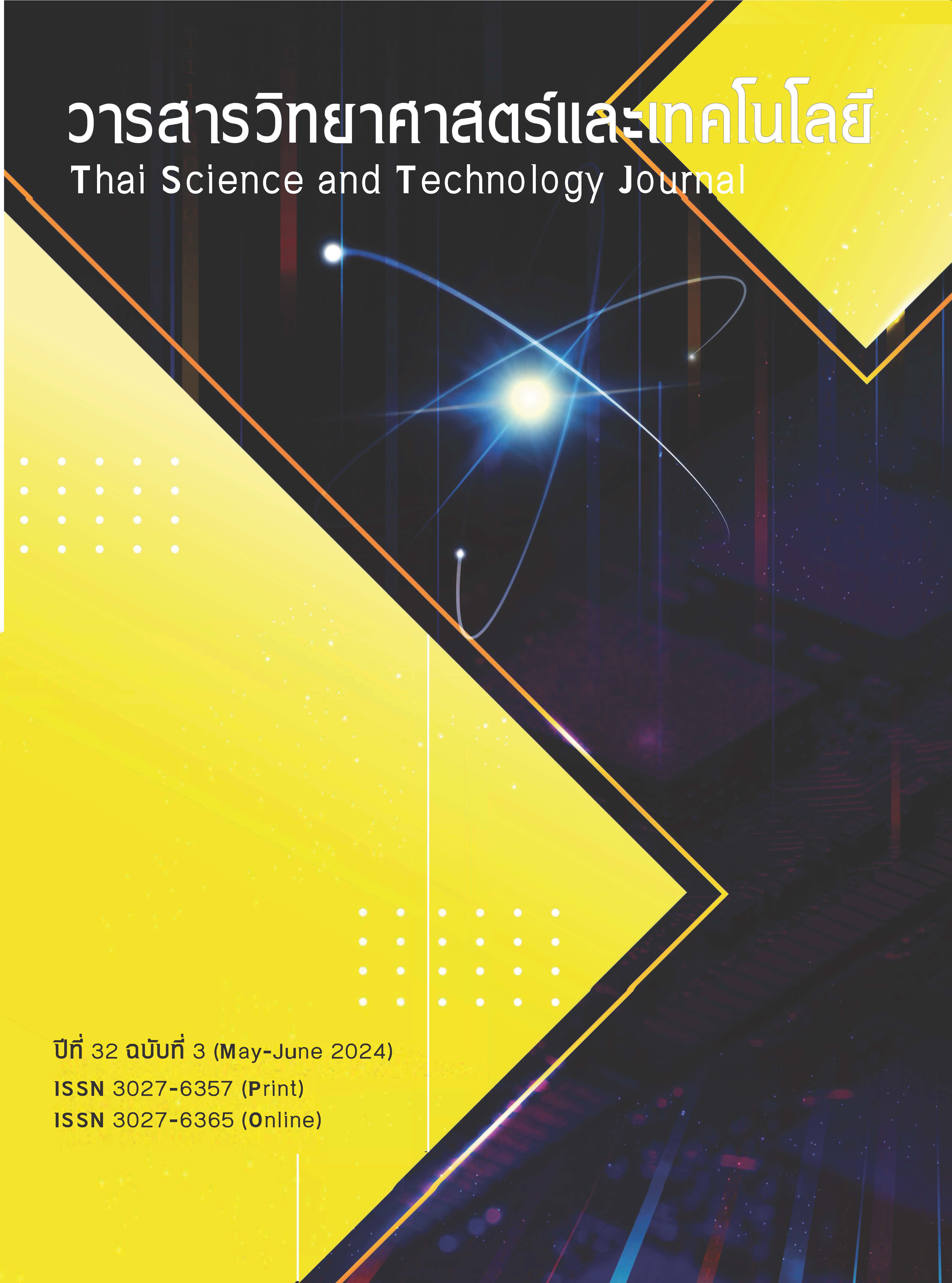Properties Evaluation of Natural Sea Water for Biodegradation Test According to ASTM D6691
Main Article Content
Abstract
The evaluation of the properties of natural seawater for a biodegradation test in accordance with ASTM D6691 was performed by utilizing seawater from the eastern coast of Thailand, specifically Chonburi Province (CB) and Rayong Province (RY). Samples were collected three times throughout the year: in November 2021, March, and July 2022. The results indicated that, over the study period, the average biodegradation percentages of the positive reference substance (cellulose chromatography grade) in both seawater samples ranged from 72.90% to 94.33% within the 28-day test period. This range aligns with the criteria outlined in ASTM D6691, which specifies that the biodegradation value of the positive reference substance must exceed 70% within the 10 to 90 days period. In conclusion, both sources of natural seawater exhibit properties suitable for assessing biodegradation according to ASTM D6691. For the upcoming study, the collection area for seawater will be expanded to validate the test method and provide evidence of its accuracy and reliability in the biodegradation testing of plastics in seawater.
Article Details
References
Department of Economic and Social Affairs United Nations, 2017, World Population Prospects,
Available Source: https://www.un.org/en/desa/world-population-projected-reach-98-billion-2050-
and-112-billion-2100, May 10, 2023.
Rouch, D., 2019, Plastic Future: How to Reduce the Increasing Environmental Footprint of Plastic
Packaging Report, Available Source: https://www.researchgate.net/publication/337506127, March 13,
Jambeck, J.R., Geyer, R., Wilcox, C., Siegler, T.R., Perryman, M., Andrady, A., Narayan, R. and Law, K.L., 2015, Plastic waste inputs from land into the ocean, Sciencemag, 347(6223): 768-771.
Office of Natural Resources and Environmental Policy and Planning, 2021, June 4, 2022, Thailand ranks third in the world in generating waste, Available Source: https://www.onep.go.th/4 มิถุนายน 2565 ไทยสร้างขยะมาก.html., March 13, 2023. (in Thai)
Melvilly, S.F.,2021, Ranked: The top 10 countries that dump the most plastic into the ocean, Available Source: https://www.euronews.com/green/2021/06/22/ranked-the-top-10-countries-that-dump-the-most-plastic-into-the-ocean, March 15, 2023.
Bethanie, M., Linn, A., Sofia, R., Petersson, H., Johansson, M. and Persson, N., 2018, Quantifying shedding of synthetic fibers from textiles; a source of microplastics released into the environment. Environ. Sci. Pollut. Res. Int. 25(2): 1191-1199.
Saelee, P., Wongsoonthornchai, M. and Phasukphan, N., 2021, The Contamination of Microplastics in Mussel (Mytilus edulis), and Oyster (Crassostrea gigas): A Case Study from a Fish Market, Chonburi Province, Burapha Sci. J., 26(3): 1726-1744. (in Thai)
American Society for Testing and Materials, 2017, ASTM D6691-17: Standard test method for determining aerobic biodegradation of plastic materials in the marine environment by a defined microbial consortium or natural sea water inoculum.
Tachibana, K., Urano, Y. and Numata, K., 2013, Biodegradability of nylon 4 film in a marine environment, Polym. Degrad. Stab., 2013(98): 1847-1851.
Narancic, T., Verstichel, S., Reddy, Chaganti, S., Morales-Gamez, L., Kenny, S., Dewilde, B., Padamati, R. and O’Connor, K., 2018, Biodegradable plastic blends create new possibilities for end-of-life management of plastics but they are not a panacea for plastic pollution, Environ. Sci. Technol., 52(18): 10441-10452.
Meereboer, K., Misra, M. and Mohanty, A., 2020, Review of recent advances in the biodegradability of polyhydroxyalkanoate (PHA) bioplastics and their composites, Green. Chem., 22: 5519-5558.
Google Developer, 2023, Google Maps JavaScript API v3.54. Accessed November 20, Available from
https://www.google.com/maps/@12.9386688,101.5369872,119516m/data=!3m1!1e3?authuser=0&entry=ttu
APHA, AWWA and WEF, 2017, Standard Methods for the Examination of Water and Wastewater (23rd ed., Part 4500), Washington DC: American Public Health Association.
Lynn Serbruyns, 2018, Marine aerobic biodegradation test of NuPlastiQ GP 1000, Available Source: https://www. biologiq.com/wp- content/uploads/2022/05/RA.DRA-8_Rev00.pdf., December 8, 2022.
Supleco®, 2022, Safety data sheet of cellulose, CAS no. 9004-34-6, Copyright 2020 Sigma-Aldrich Co. LLC.
International Organization for Standardization ISO 9408, 1999, Water quality - Evaluation of ultimate aerobic biodegradability of organic compounds in aqueous medium by determination of oxygen demand in a closed respirometer, Switzerland ISO copyright, 22pp.
National Environment Board, 2021, Announcement of the National Environment Board on the Determination of Sea Water Quality Standards., October 6, 2021. (in Thai)
Musika, C., Wongsudawan, W., Munhapon, A. and Thongra-ar, W., 2007, A Situation of Coastal Water Quality along the Eastern Coast of Thailand in 2005, Burapha Sci. J., 12(1): 33-44. (in Thai)
Kim, C., Wilkins, K., Bowers, M., Wynn, C. and Ndegwa, E., 2018, Influence of Ph and Temperature on Growth Characteristics of Leading Foodborne Pathogens in a Laboratory Medium and Select Food Beverages. Austin Food Sci., 3(1): 1-8.
WTW GmbH, 2019, Operating manual System Oxitop Control, Weilheim Germany.
Tanadchangsaeng, N. and Pattanasupong, A., 2022, Evaluation of Biodegradabilities of Biosynthetic polyhydroxyalkanoates in Thailand Seawater and Toxicity Assessment of Environmental Safety Levels. Polymers, 2022, 1-14.


